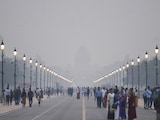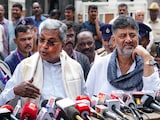The government claims to spend lakhs of rupees every day to nourish children across Madhya Pradesh. The Anganwadi registers proudly record a daily expenditure of Rs 8 per child for nutrition of malnourished children and Rs 12 for severely malnourished children. But somewhere between those eight and twelve rupees, a four-month-old baby named Hussain Raza took his last breath, another statistic in a state that has forgotten how to feed its youngest.
Last week, at the Satna District Hospital, the ICU monitor beeped softly, marking the rhythm of a life slipping away. A young mother sat beside a steel cot, motionless, her face pale under the harsh white light. Her baby's ribs showed through paper-thin skin, his lips cracked and dry as if hunger had erased even the instinct to cry.
"I last saw him with my finger on his lips," says Asma Bano, Hussain's mother. "The nurse said he was very weak. They kept changing machines, inserting tubes... but my son kept slipping away. My two-and-a-half-pound baby was so light, he felt like he was resting on my soul."
For four nights, under the glare of the PICU lights, Asma watched her child fade away one breath at a time, one beep at a time. That Tuesday night, the monitor fell silent.
In Marwa village of Satna's Majhgawan block, where the red dust sticks to every wall and the nearest hospital is a two-hour ride away, Asma and her husband, Aamir Khan, live in a hut made of grass, bamboo, and plastic. The roof leaks during rains; the floor is bare earth. Inside, an empty cradle hangs from a rope, swaying slightly in the afternoon wind.
"I used to think he would grow up here, running around the fields," Asma whispers, clutching a photograph of her son. "But now there's no fragrance of soil, only smoke and silence."
Aamir, a labourer who earns barely Rs 250 a day, says, "We took him everywhere – Jaitwara, Satna, even private hospitals through Ayushman Bharat. We thought he would be fine. But nobody followed up. The Anganwadi people came just once and wrote his name. Then they vanished."
The Anganwadi system, which promises to deliver nutrition at the doorstep, never showed up again. "We never got anything," Asma says, her voice breaking. "No nutritional packets, no supplements, no visits. No one asked how our child was. All we ever got was panjiri once. He died in the hospital They told us he had pneumonia. But he was also starving."
Aamir adds bitterly, "He didn't even get his vaccines. Not one after birth. How could he fight pneumonia without strength?"
According to health department records, Hussain was born weighing three kilograms perfectly healthy. But by the time he died, his weight had dropped to 2.5 kilograms. He had received only the birth doses of OPV, Hepatitis B, and BCG vaccines and none thereafter. He wasn't even listed in the Dastak Abhiyan, the very campaign designed to identify malnourished children between 0 and 5 years of age.
When questioned, the local Anganwadi worker Shakun Gautam claimed the family had left the village during the survey. But a joint inspection by the Child Development Project Officer (CDPO) and supervisor later exposed the lie. Asma and her child were living in Marwa all along.
The investigation revealed that Hussain was never admitted to a Nutrition Rehabilitation Centre (NRC), nor was he marked as severely malnourished in government records. In effect, he did not exist in the system that was supposed to save him.
In Satna district alone, 7,935 children are classified as malnourished, 1,451 severely so. Between April and September 2025, 1,209 malnourished children were admitted to nine NRCs in Satna and Maihar, averaging 200 every month. At the Panas Anganwadi Centre in the Nagaud project, seven of nineteen children were found to be severely malnourished 36 percent, nearly six times the prescribed limit.
Across 125 Anganwadi centres, the rate of malnutrition far exceeds government standards. While the state's official malnutrition rate is 7.79 percent, compared to the national average of 5.4 percent, ground realities show entire pockets of rural Madhya Pradesh surviving on paper nutrition and phantom schemes.
Under a neem tree in Marwa, a group of women gather, their faces lined with fatigue, their voices heavy with resignation. "There's an ASHA worker here, but she never visits," says one woman. "No one asks what's wrong with our children. Pregnant women get neither iron bottles nor vaccines. The Anganwadi workers write names, but no food comes. When we go for vaccination, we stand all day, our feet swell, and they tell us to come next week."
Their children play nearby, barefoot, their bellies swollen from hunger. "The government says there's poshan for every child," another mother says. "We've only seen hunger."
Dr. Rupesh Soni, BMO of Majhgawan, confirms the sequence of events. "He was admitted to the district hospital on October 17 and died after 2-3 days. The cause was pneumonia coupled with malnutrition," he said.
Show-cause notices have been issued to Khutha Medical Officer Dr. S.P. Srivastava, health worker Lakshmi Rawat, and ASHA worker Urmila Satnami. But accountability, as always, rarely travels beyond paperwork.
There are 2,054 Anganwadi centres in Satna alone, thousands of employees, countless reports, and yet, for Hussain, there was no milk, no monitoring, no rescue.
Nirmala Bhuria, Minister of Women and Child Development, called it a challenge that extends beyond one state. "Malnutrition is a global issue. Awareness is equally important. Our government is constantly working to eliminate malnutrition in both rural and urban areas. We have also demanded more support from the central government," she said.
But in Marwa, the air is thick with silence. The Anganwadi register still records Rs 8 for "malnourished" children and Rs 12 for "severely malnourished" ones. Asma's lap, once filled with laughter, is now empty. The government's files are full.
And somewhere between eight and twelve rupees, another life was priced, processed, and lost.















